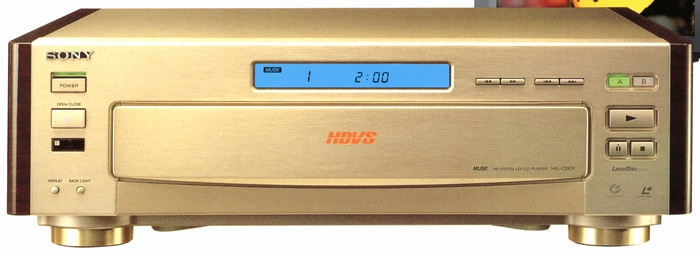
SONY HIL-C2EX
¥ 298,000 (around 1996)
Commentary
An LD player compatible with Hi-Vision LD.
The mechanism section employs a newly developed high-speed double-sided reproduction mechanism.
This mechanism uses a parallel tilt system that allows both A and B sides of a warped disc to be reproduced under the same conditions. In addition, the optical block is supported by a double support system to minimize slight shaking and vibration.
In addition, the effect of vibration is completely eliminated by adopting a belt drive system for the sled drive that moves the optical block and floating tilt and sled motors.
We have also newly developed FND (frame number decoder)) LSIs and spindle servo LSIs to reduce image output time.
The pickup section is equipped with a short-wavelength laser pickup with a wavelength of 670 nm that uses a self-pulsation red diode as the light source. In addition, the objective lens uses a highly reliable aspherical glass lens. In this way, we are thoroughly pursuing higher precision and stability in signal reading. This greatly reduces crosstalk even in NTSC LD reproduction, contributing to higher picture and sound quality.
In addition, the effect of external noise is eliminated by using a differential RF output for signal transmission to the video circuit.
Uses G chassis and G tray with high rigidity and excellent vibration absorption.
In addition, the spindle motor is equipped with a 3-phase brushless motor that provides high torque and smooth rotation that is directly attached to the G chassis. In addition, a die-cast turntable is used for the spindle motor, which is designed to prevent vibration.
In addition to the NTSC LD, the Hi-Vision LD uses the first digital frame memory for a home LD player, enabling still image playback and variable-speed playback with the same beautiful picture quality as normal playback.
The NTSC LD can be switched to the field memory according to the software.
Direct video output via the BNC terminal is possible, and external independent Y/C separation circuits can be connected.
In addition to significant improvements in crosstalk and S / N degradation in long-time disks due to the use of short-wavelength lasers, high-quality composite output is achieved through balanced transmission and high-precision BPF.
It is equipped with a motion-adaptive three dimensional Y/C separation circuit using a 6-megabit digital memory.
For still images, the luminance signal and color signal are separated with high precision by 3-dimensional processing that compares the correlation between frames on a pixel-by-pixel basis. For moving images where there is no correlation between frames, a proprietary high-precision 3-line digital comb filter is used. This greatly reduces cross-color and dot interference, and greatly improves diagonal resolution and signal-to-noise ratio.
In addition, the digital TBC using 1-inch commercial VTR technology suppresses color unevenness caused by disc eccentricity and maximizes the characteristics of the Y/C separation circuit.
It is equipped with motion-adaptive 3 d digital CNR (Chroma Noise Reduction), the first home-use LD player, and significantly reduces color noise without degrading vertical resolution through frame processing.
As in-field processing, the moving image portion is processed with high precision according to the image condition to reproduce beautiful images.
Sony's proprietary MUSE high-resolution technology has been introduced, and it is equipped with a new TBC system that combines a PILOT/H TBC and 32.4 MHz oversampling.
The new TBC for PILOT/HTBC uses both the PILOT signal method, which locks the time axis immediately when the disc starts to rotate stably, and the H (horizontal synchronous) signal method, which enables cooperative error correction when the disc rotates stably. The PILOT TBC is used for playback start and high-speed scanning, and when the disc moves to a good regenerating condition, it switches to HTBC to maintain high time axis accuracy, and realizes more stable high-definition video playback.
The 32.4 MHz oversampling circuit doubles the sampling frequency of 16.2 MHz, which is the minimum required for processing MUSE signals, to 32.4 MHz. As a result, the filter characteristics of analog circuits are relaxed and transmission characteristics are greatly improved, and reproducibility of high-frequency signal components such as details is enhanced.
The D/A converter uses an advanced pulse D/A converter, and the digital filter uses a full feed-forward digital filter to improve low-level distortion.
A DC servo amplifier is used for the line amplifier section.
The power supply section is equipped with a dedicated power supply circuit for audio with R-core transformer to reduce interference between the circuits.
There are 2 color variations of gold and titanium gray.
Wireless remote control is included.
Model Rating
| Type | LD Player |
| D/A converter | Advanced PULSE |
| Digital filter | 8fs 45bit |
| Frequency characteristic | 4 Hz to 20 kHz |
| Digital voice S/N ratio | 115 dB or more (EIAJ) |
| Dynamic range | 99 dB or More (EIAJ) |
| Wow and flutter | Below the limit of measurement (± 0.001% Wpeak) (EIAJ) |
| Horizontal Resolution | Hi-Vision : 650 units NTSC : 425 |
| Video S/N ratio | 52 dB or more |
| Digital memory | 8bit(4fsc) |
| MUSE Output | Route 2 |
| S Video Output | 2 systems (3 d) |
| Line Out (Video) | 2 Systems (Gold Plated) |
| Line Out (Audio) | 2 Systems (Gold Plated) |
| Direct video output | 1 System (BNC Terminal) |
| Optical digital output | Route 1 (Analog audio of LD and audio of video CD cannot be output.) |
| Control S input / output | One input line only |
| Power consumption | 68W |
| External dimensions | Width 470x Height 142x Depth 419 mm |
| Weight | 14.0kg |
| Attachment | Wireless Remote Control RMT-M28 |
.jpg)
.jpg)
.jpg)
.jpg)
.jpg)
.jpg)
.jpg)